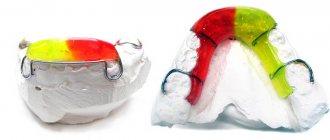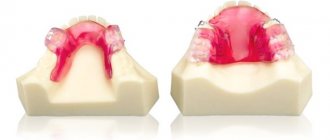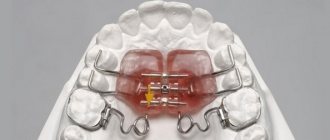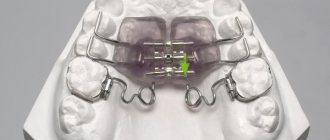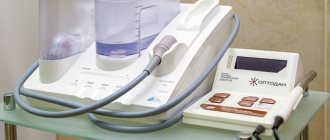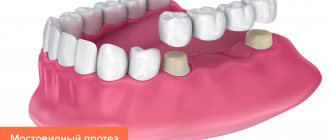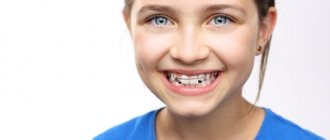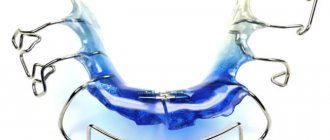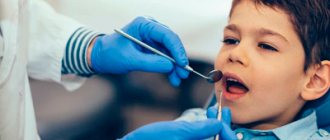Types of fixed devices
I prefer devices from leading dental brands. We will decide which option is right for your child after examination and diagnosis. We will select a model that corrects the defect, is positively perceived by the young patient, and is affordable financially.
Haas/Marco Ross devices
This is a new level of defect correction. The device was first introduced by Mark Ross - he used a titanium screw. But Andrew Haas improved the design by using a stronger and more powerful screw - the Hyrex screw.
The corrective structure is assembled from a screw, a base made of light plastic, support rings and grips (“claws”) made of metal for fixation on primary chewing teeth, and is attached to temporary fangs with filling material. Such devices allow you to expand the upper jaw as much as the situation requires. They are made from a mold for each baby. If the anomaly is complicated, then the modifications are supplemented with other necessary elements.
The device is installed so that the jaw is formed adequately, and there is a place for each tooth. Its advantages:
- Comfortable to wear, beautiful, you can choose the color of the plastic or the pattern. Unnoticeable to others, but the baby knows that there are amazing butterflies and simply beautiful products in his mouth.
- Attaches firmly.
- The addiction is quick, the discomfort in the first days is minimal.
- Simple application - the screw is tightened, the palatal suture expands and stimulates the correct formation of the jaw.
The device will cope with bite correction independently or, in difficult cases, will reduce the period of follow-up treatment in adolescents with a brace system from 12-18 months. up to six months.
Distal Jet
A gentle device that initiates movement of the first and second molars without tilting or rotation. The effect is visible after 3-4 months. It consists of a solid plastic palate, fastening rings for chewing units and an activation screw responsible for the smooth movement of the teeth. Treatment of adults and adolescent children is possible.
Career motion 3D
Often used as preparation for installing braces. The task is to gently shift the lateral units of the jaw back. This is an upper partial arch plus a bracket for the lower molars. Class 2 elastics are used, suitable for teenage children and adults.
Jasper Jumper, Distal Jet
Content
- Indications for use
- Operating principles and wearing rules
- Terms of use of Jasper Jumper, Distal Jet devices
- Advantages and disadvantages of the design
The Jasper Jumper and Distal Jet devices belong to the group of additional orthodontic structures. Their main task is to increase the load on the lateral chewing teeth in order to move them faster and more efficiently.
The Jasper Jumper device enhances the effect of braces when straightening teeth
Indications for use
- increasing pressure on the lateral teeth for better displacement, including around their axis (Jasper Jumper device),
- moving back a group of lateral teeth of the upper jaw (Distal Jet device),
- treatment in adults and children,
- self-treatment (Distal Jet device),
- additional treatment in the presence of braces in the oral cavity (both devices are used).
Devices Jasper Jumper, Distal Jet: operating principles and wearing rules
The Jasper Jumper is a spring enclosed in a rubber casing. The structure is attached to braces or two supporting teeth of the upper and lower jaw. When activated, the spring expands and puts the necessary load on the chewing teeth, ensuring their more efficient movement. This design is used only if there are braces in the oral cavity.
The Distal Jet device can be used either independently or simultaneously with braces. It consists of a thin plastic base that rests on the upper palate, two clamps or rings that secure the structure to the molars. And also two arches connected by an activation screw, which move the lateral teeth back.
Both devices belong to the group of non-removable structures, so they must be worn constantly for several months.
Terms of use of Jasper Jumper, Distal Jet devices
The duration of use of additional orthodontic structures will depend on the complexity of the malocclusion, the age of the patient and the characteristics of his body, and on how far the lateral teeth need to be moved. On average, the designs will have to be worn for 1-2 months or more. With simultaneous treatment with braces, the wearing time of the structures is reduced.
Advantages and disadvantages of the design
The Jasper Jumper device looks quite massive and sometimes causes much more inconvenience than installed braces. After fixing the structure, quite severe pain in the jaw is possible due to increased load on the teeth, and slight rubbing of the mucous membrane.
If you have a device in the oral cavity, you must be careful when feeding it - strong pressure can lead to peeling and breakage of the structure.
The use of Distal Jet for bite correction is an effective and very gentle remedy for patients. Externally, the device is completely invisible and after a little adaptation it causes only minor discomfort. Caring for the structure does not cause any particular difficulties. The plastic base is thin and fits tightly to the upper palate. It is enough for the patient to regularly and thoroughly brush his teeth, carry out antibacterial rinses, and clean the interdental spaces after each meal using dental floss or orthodontic micro-brushes.
Also see:
Facebow
FORSUS device
Thank you! Your request will be processed within 12 hours.
Free consultation
How is the Haas apparatus installed?
In fact, installing the device in the attending physician’s office is quite simple and does not take long:
- In a friendly atmosphere, we clean the enamel of plaque with a pleasant aromatic paste.
- We use dental glue - a safe cement - and fix the device onto the primary chewing teeth and canines.
- Excess filling material is removed and the interdental spaces are cleaned.
- The composite material becomes strong under the light of the lamp.
I use modern technologies and equipment; my child and I discuss the design of the device and the need for its installation as equals. Before the correction begins, together with the parents we discuss the problem and ways to solve it. Make an appointment and we will make sure your baby's teeth are perfect.
The essence of the procedure
Correction of anomalies affecting the development of bite is carried out in various ways. Each of the existing devices, from braces to trainers, is characterized by certain advantages and disadvantages - both from the point of view of medical effectiveness and from the position of the patient, who is forced to deal with physical and moral inconveniences during the treatment process. Choosing the appropriate technique is the key to effective and comfortable recovery.
External devices
Distalization of molars is carried out in accordance with two protocols - external and internal. For the first method, traction devices are used, fixed on the vestibular (external) surface of the dentition, and requiring strict adherence by the patient to medical recommendations.
The practice of using devices in this category is controversial, and is mostly recommended for correction prescribed to younger patients. Such a tilt is caused not only by a low force effect, insufficient to significantly change the structure of the permanent bite, but also by an unaesthetic appearance, which can create significant inconvenience for adults. Correctors are produced on a serial basis - the design combines two power arches, one of which is selected taking into account the anatomical structure of the jaw.
Internal devices
Intraoral corrective devices, in accordance with the accepted classification, are divided into permanent and removable - based on the criterion of the possibility of their independent removal and installation without visiting a dental clinic.
The first group is considered the most effective devices, which is caused by constant directed pressure exerted on defective elements of the dentition. The structure is fixed and remains on the teeth until the end of treatment, the duration of which depends on the severity of the pathology - from 2-3 months to one and a half to two years. It is worth noting that while wearing the corrector, you will also need to regularly visit your doctor to monitor the dynamics and activation of the device. At the same time, the lack of the option to remove the product, at least temporarily, makes hygienic dental care difficult and requires psychological adaptation.
However, statistics show that fixed orthodontic appliances for molar distalization remain the most practical correction option. Among the popular models recommended by dentists are:
- Pendulum - systems that combine a power arc and fixing rings, fixed to the supporting chewing units. The base is a polymer plate that fits tightly to the surface of the palate;
- Distal Jet is a device oriented towards the reverse displacement of molars, which includes a screw design. Regular activation of the screw provides the necessary tension, preserves the integrity of tooth enamel, and helps avoid rotation of adjacent elements;
- FROG is a non-removable model for the correction of torsion, which is a structure consisting of a palatal plate, screws, spring elements and supporting artificial crowns.
The duration of molar distalization ranges from three to nine months.
Stages of treatment
Diagnostics
The specialist assesses the condition of the oral cavity: if there are caries or inflammatory diseases, they must be cured before orthodontic correction begins. Professional oral hygiene is also required. Only then can an orthodontic treatment plan be drawn up.
Preparing to install an orthodontic system
Regardless of the chosen correction method, impressions are taken of the teeth, an X-ray of the jaw and a CT scan are taken. This is necessary to produce an orthodontic system that is ideal for a particular patient.
Installation of an orthodontic system
On average, external braces are installed in an hour; installation of lingual braces will take about 2 hours. The process of installing braces: the teeth are treated with a special substance, then a bracket is attached to each tooth, after which they are connected with tightening arches. You need to go for braces correction regularly, usually once every 4-6 weeks. After installing braces and correction, discomfort may occur. But they disappear within a few days, and in some patients they do not occur at all. It is important to understand that after treatment you will have perfectly straight, beautiful teeth. Braces require especially careful care; it is important to brush your teeth twice a day, use an irrigator, and dental floss so that food debris does not accumulate in the elements of the orthodontic structure.
GUTA CLINIC: full range of services in the field of orthodontics
The clinic provides a full range of services in the field of orthodontics. It has a modern diagnostic base and cooperates with leading dental laboratories.
When choosing a technique for correcting a bite, the individual characteristics of the patient, his age and, of course, personal preferences must be taken into account.
Trainers
Removable devices made of elastic medical silicone. This material is hypoallergenic and does not injure the gums. They are used primarily to correct mild malocclusions in children from 4 to 14 years old - their use is most optimal during the change of teeth from milk to permanent ones.
Trainers allow you to:
- straighten the front teeth;
- neutralize the consequences of childhood habits (biting the tongue, lips or cheeks, mouth breathing; thumb sucking, jaw clenching, teeth grinding, etc.)
- correct the incorrect swallowing mechanism, the position of the tongue in the child’s mouth;
In adult patients, strainers are noticeably less effective. However, they are sometimes used in adult orthodontics - when a light correction is required or to stabilize teeth after treatment with braces.
Removable plates
A “classical” technique that does not lose its relevance in pediatric orthodontics. The high-strength plastic structure is attached to the teeth using hooks and fasteners; the system can be narrowed or expanded by rotating the adjusting screw. The “plates” gradually move the teeth into the desired position. The devices are manufactured strictly individually (based on an impression) and exactly match the anatomical features of the child.
Distal Jet
Used to move the lateral teeth (molars) of the upper jaw back. Effective in both children and adults. Easy to use - there is no need to remove/put on the device. Almost invisible to outsiders. Does not injure soft tissues of the oral cavity. And the main thing is to maintain the stability of the molars: the teeth move practically without rotation or tilting.
Aligners, aligners
An alternative to permanent braces in cases where minor irregularities need to be corrected.
They are made individually, based on an impression, from highly elastic polymer using 3D printing. The design of the mouth guards accurately imitates the outlines of all surfaces of the dentition. In this case, it is not just one mouthguard that is worn out, but a whole set, in which each mouth guard is slightly different from the previous one. Removable aligners must be replaced every two weeks. The purpose of each new aligner is to change the position of the teeth and put them in the desired position. The obvious advantages of a mouth guard include:
- versatility - applicable at any age.
- do not cause allergies,
- do not injure soft tissues, do not damage tooth enamel.
- Easy to put on and take off, making oral hygiene convenient
Bracket systems
Another classic method of correcting a bite is to violate the relationship between the upper and lower jaws, correct the position of the teeth, and eliminate large gaps between them. It is successfully used to treat both children and adults.
A complex system is applied to the teeth, which is made according to an individual model for each patient. Braces apply pressure on each tooth at a predetermined angle, forcing them into the desired position.
Traditionally, braces are attached to the outside of the teeth ( vestibular fixation technique
). This affects appearance, but does not affect diction and provides faster correction
Nevertheless, lingual systems
. They are attached to the inner - from the side of the tongue - surface of the teeth. They are invisible from the outside, but can affect speech intelligibility and require more time to get used to. And in general, treatment is approximately 30% longer than with vestibular fixation.
